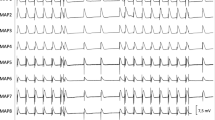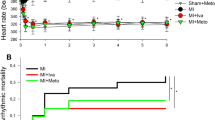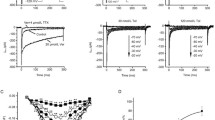Abstract
To investigate the pharmacological effect of procainamide on transmural ventricular repolarisation in normal heart, the transmural activation-recovery intervals (ARI) and their responses to procainamide (20 mg/min i.v. for 20 min) were studied in 6 open-chest, pentobarbitone-anaesthetised sheep. ARI was measured from the unipolar ECGs acquired with 4 plunge needles inserted into the basal and apical parts of the left ventricular wall. During sinus rhythm (cycle length 500–700 ms), there was no significant difference in the pooled ARI between the epicardium (266.0 ± 30.5 ms), midmyocardium (265.0 ± 28.9 ms) and endocardium (265.7 ± 28.1 ms) (p > 0.05). Procainamide prolonged ARI in all myocardial layers. The pooled ARI prolongation from the epicardium, midmyocardium and endocardium of the 6 animals was 66.8 ± 18.3, 70.3 ± 14.7 and 65.3 ± 15.7 ms (p > 0.05), respectively. In conclusion, sodium channel blocker procainamide results in a similar repolarisation prolongation in the left ventricular epicardium, midmyocardium and endocardium of a healthy heart.
Similar content being viewed by others
References
Mark LC, Berlin I, Kayden HJ, Rovenstine EA, Steele JM, Bfrodie. The action of procaine amide on ventricular arrhythmias. Abstract. J Pharmacol Exp Ther 1950;98:21.
Kadish AH, Spear JF, Levine JH, Moore EN. The effects of procainamide on conduction in anisotropic cainine ventricular myocardium. Circulation 1986;74:616–625.
Cascio WE, Foster JR, Buchanan JW, Jr, Johnson TA, Gettes LS. Enhancement of procainamide-induced rate-dependent conduction slowing by elevated myocardial exteracellular potassium. Circulation 1987;76:1380–1387.
Nattel S, Jing W. Rate-dependent changes in intraventricular conduction produced by procainamide in anesthetized dogs. A quantitative analysis based on the relation between phase 0 inward current and conduction velocity. Circ Res 1989;65:1485–1498.
Kirchhof PF, Fabritz CL, Franz MR. Postrepolarisation refractoriness versus conduction slowing caused by class I antiarrhythmic drugs: Antiarrhythmic and proarrhythmic effects. Circulation 1998;97:2567–2574.
Woske H, Belford J, Fastier FN, Brooks CM. The effect of procainamide on excitability, refractoriness and conduction in the mammalian heart. J Pharmacol Exp Ther 1953;107:134.
Levites R, Haft JI, Calderon J. Effects of procainamide on the dispersion of recovery of excitability during coronary occlusion. Circulation 1976;53(6):982–984.
Shechter JA, Caine R, Friehling T, Kowey PR, Engel TR. Effects of procainamide on dispersion of ventricular refractoriness. Am J Cardiol 1983;52:279–282.
Lee RJ, Liem LB, Cohen TJ, Franz MR. Relation between repolarization and refractoriness in the human ventricle: Cycle length dependence and effect of procainamide. JAmColl Cardiol 1992;19:614–618.
Millar CK, Kralios FA, Lux RL. Correlation between refractory periods and activation-recovery intervals from electrograms: Effects of rate and adrenergic interventions. Circulation 1985;72:1372–1379.
Haws CW, Lux RL. Correlation between in vivo transmembrane action potential duration and activation-recovery intervals from electrograms: Effects of interventions that alter repolarisation time. Circulation 1990;81:281–288.
Statters DJ, Malik M, Ward DE, Camm AJ. QT dispersion: Problems of methodology and clinical significance. J Cardiovasc Electrophysiol 1995;5:672–685.
Sosunov EA, Anyukhovsky EP, Feinmark SJ, Rosen MR. Effects of quinidine on repolarisation in canine epicardium, midmyocardium, and endocardium. I. In vitro study. Circulation 1997;96:4019–4026.
Anyukhovsky EP, Sosunov EA, Rosen MR. Regional differences in electrophysiological properties of epicardium, midmyocardium, and endocardium: In vitro and in vivo correlations. Circulation 1996;94:1981–1988.
Anyukhovsky EP, Sosunov EA, Feinmark SJ, Rosen MR. Effects of quinidine on repolarisation in canine epicardium, midmyocardium, and endocardium. Circulation 1997;96:4019–4026.
Haberman RJ, Rials SJ, Stohler JL, Marinchak RA, Kowey PR. Evidence for a reexcitability gap in man after treatment with type-I antiarrhythmic drugs. Am Heart J 1993;126:1121–1126.
Sicouri S, Antzelevitch C. A subpopulation of cells with unique electrophysiological properties in the deep subepicardium of the canine ventricle: The M cell. Circ Res 1991;68:1729–1741.
Antzelevitch C, Sicouri S. Clinical relevance of cardiac arrhythmias generated by afterdepolarisations: The role of M cells in the generation of U waves, triggered activity and torsade de pointed. J Am Coll Cardiol 1994;23:259–277.
Antselevitch C, Shimizu W, Yan GX, et al. The M cell: Its contribution to the ECG and to normal and abnormal electrical function of the heart. J Cardiovasc Electrophsiol 1999;10:1124–1152.
Sicouri S, Moro S, Litovsky S, Elizari MV, Antzelevitch C. Chronic amiodarone reduces transmural dispersion of repolarization in the canine heart. J Cardiovasc Electrophysiol 1997;8:1269–1279.
Merot J, Charpentier F, Poirier JM, Coutris G, Weissenburger J. Effects of chronic treatment by amiodarone on transmural heterogeneity of canine ventricular repolarization in vivo: Interactions with acute sotalol. Cardiovasc Res 1999;44:303–314.
Author information
Authors and Affiliations
Rights and permissions
About this article
Cite this article
Wang, L., Yong, A.C. & Kilpatrick, D. Effects of Procainamide on Transmural Ventricular Repolarisation. Cardiovasc Drugs Ther 16, 335–339 (2002). https://doi.org/10.1023/A:1021786027203
Issue Date:
DOI: https://doi.org/10.1023/A:1021786027203




